tire size PONTIAC G5 2010 User Guide
[x] Cancel search | Manufacturer: PONTIAC, Model Year: 2010, Model line: G5, Model: PONTIAC G5 2010Pages: 422, PDF Size: 2.22 MB
Page 328 of 422
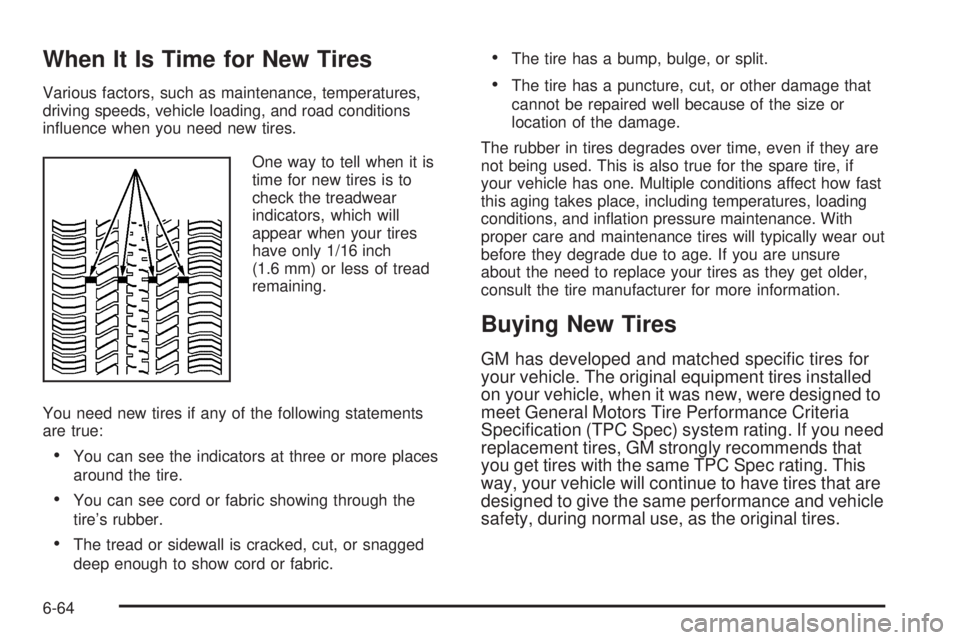
When It Is Time for New Tires
Various factors, such as maintenance, temperatures,
driving speeds, vehicle loading, and road conditions
influence when you need new tires.One way to tell when it is
time for new tires is to
check the treadwear
indicators, which will
appear when your tires
have only 1/16 inch
(1.6 mm) or less of tread
remaining.
You need new tires if any of the following statements
are true:
•You can see the indicators at three or more places
around the tire.
•You can see cord or fabric showing through the
tire’s rubber.
•The tread or sidewall is cracked, cut, or snagged
deep enough to show cord or fabric.
•The tire has a bump, bulge, or split.
•The tire has a puncture, cut, or other damage that
cannot be repaired well because of the size or
location of the damage.
The rubber in tires degrades over time, even if they are
not being used. This is also true for the spare tire, if
your vehicle has one. Multiple conditions affect how fast
this aging takes place, including temperatures, loading
conditions, and inflation pressure maintenance. With
proper care and maintenance tires will typically wear out
before they degrade due to age. If you are unsure
about the need to replace your tires as they get older,
consult the tire manufacturer for more information.
Buying New Tires
GM has developed and matched specific tires for
your vehicle. The original equipment tires installed
on your vehicle, when it was new, were designed to
meet General Motors Tire Performance Criteria
Specification (TPC Spec) system rating. If you need
replacement tires, GM strongly recommends that
you get tires with the same TPC Spec rating. This
way, your vehicle will continue to have tires that are
designed to give the same performance and vehicle
safety, during normal use, as the original tires.
6-64
Page 329 of 422
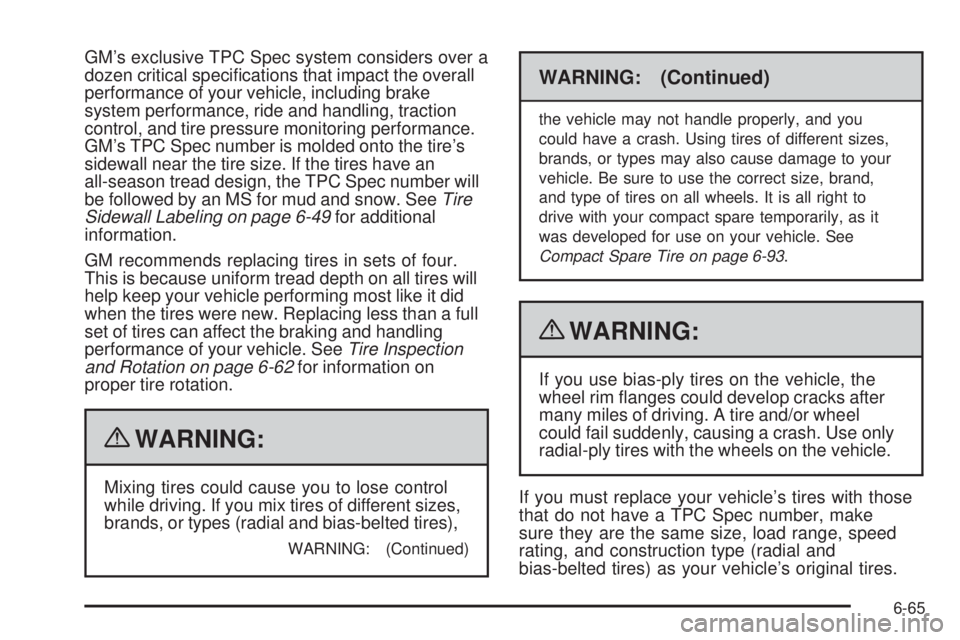
GM’s exclusive TPC Spec system considers over a
dozen critical specifications that impact the overall
performance of your vehicle, including brake
system performance, ride and handling, traction
control, and tire pressure monitoring performance.
GM’s TPC Spec number is molded onto the tire’s
sidewall near the tire size. If the tires have an
all-season tread design, the TPC Spec number will
be followed by an MS for mud and snow. SeeTire
Sidewall Labeling on page 6-49 for additional
information.
GM recommends replacing tires in sets of four.
This is because uniform tread depth on all tires will
help keep your vehicle performing most like it did
when the tires were new. Replacing less than a full
set of tires can affect the braking and handling
performance of your vehicle. See Tire Inspection
and Rotation on page 6-62 for information on
proper tire rotation.
{WARNING:
Mixing tires could cause you to lose control
while driving. If you mix tires of different sizes,
brands, or types (radial and bias-belted tires),
WARNING: (Continued)
WARNING: (Continued)
the vehicle may not handle properly, and you
could have a crash. Using tires of different sizes,
brands, or types may also cause damage to your
vehicle. Be sure to use the correct size, brand,
and type of tires on all wheels. It is all right to
drive with your compact spare temporarily, as it
was developed for use on your vehicle. See
Compact Spare Tire on page 6-93 .
{WARNING:
If you use bias-ply tires on the vehicle, the
wheel rim flanges could develop cracks after
many miles of driving. A tire and/or wheel
could fail suddenly, causing a crash. Use only
radial-ply tires with the wheels on the vehicle.
If you must replace your vehicle’s tires with those
that do not have a TPC Spec number, make
sure they are the same size, load range, speed
rating, and construction type (radial and
bias-belted tires) as your vehicle’s original tires.
6-65
Page 330 of 422
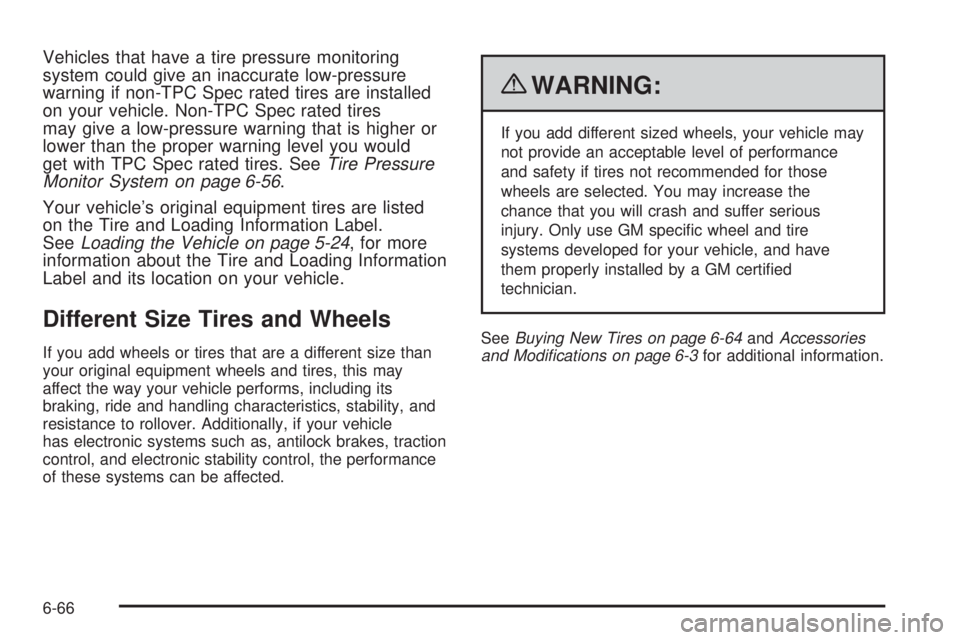
Vehicles that have a tire pressure monitoring
system could give an inaccurate low-pressure
warning if non-TPC Spec rated tires are installed
on your vehicle. Non-TPC Spec rated tires
may give a low-pressure warning that is higher or
lower than the proper warning level you would
get with TPC Spec rated tires. SeeTire Pressure
Monitor System on page 6-56 .
Your vehicle’s original equipment tires are listed
on the Tire and Loading Information Label.
See Loading the Vehicle on page 5-24 , for more
information about the Tire and Loading Information
Label and its location on your vehicle.
Different Size Tires and Wheels
If you add wheels or tires that are a different size than
your original equipment wheels and tires, this may
affect the way your vehicle performs, including its
braking, ride and handling characteristics, stability, and
resistance to rollover. Additionally, if your vehicle
has electronic systems such as, antilock brakes, traction
control, and electronic stability control, the performance
of these systems can be affected.
{WARNING:
If you add different sized wheels, your vehicle may
not provide an acceptable level of performance
and safety if tires not recommended for those
wheels are selected. You may increase the
chance that you will crash and suffer serious
injury. Only use GM specific wheel and tire
systems developed for your vehicle, and have
them properly installed by a GM certified
technician.
See Buying New Tires on page 6-64 andAccessories
and Modi�cations on page 6-3 for additional information.
6-66
Page 334 of 422
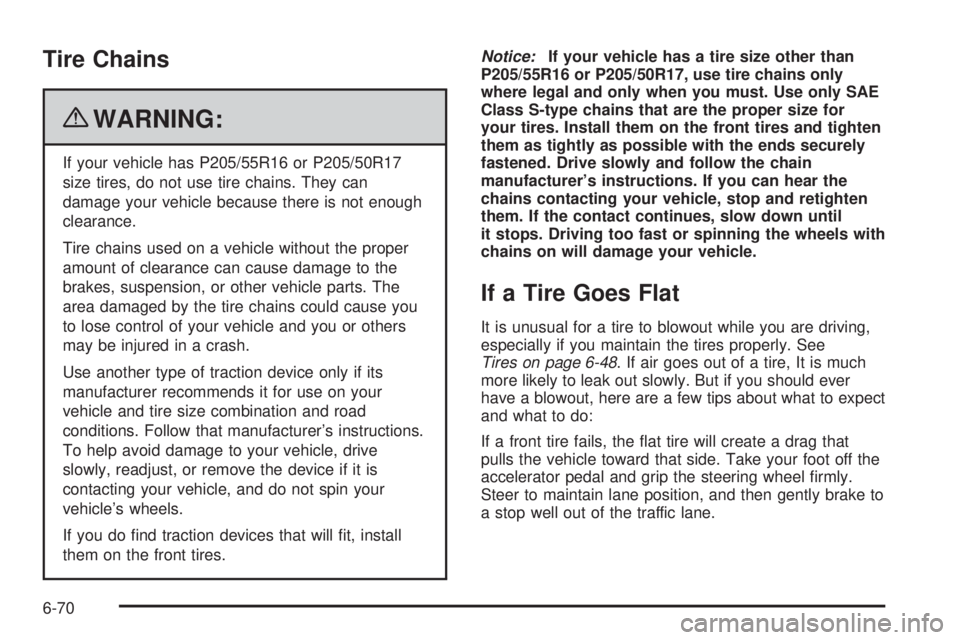
Tire Chains
{WARNING:
If your vehicle has P205/55R16 or P205/50R17
size tires, do not use tire chains. They can
damage your vehicle because there is not enough
clearance.
Tire chains used on a vehicle without the proper
amount of clearance can cause damage to the
brakes, suspension, or other vehicle parts. The
area damaged by the tire chains could cause you
to lose control of your vehicle and you or others
may be injured in a crash.
Use another type of traction device only if its
manufacturer recommends it for use on your
vehicle and tire size combination and road
conditions. Follow that manufacturer’s instructions.
To help avoid damage to your vehicle, drive
slowly, readjust, or remove the device if it is
contacting your vehicle, and do not spin your
vehicle’s wheels.
If you do find traction devices that will fit, install
them on the front tires.Notice:
If your vehicle has a tire size other than
P205/55R16 or P205/50R17, use tire chains only
where legal and only when you must. Use only SAE
Class S-type chains that are the proper size for
your tires. Install them on the front tires and tighten
them as tightly as possible with the ends securely
fastened. Drive slowly and follow the chain
manufacturer’s instructions. If you can hear the
chains contacting your vehicle, stop and retighten
them. If the contact continues, slow down until
it stops. Driving too fast or spinning the wheels with
chains on will damage your vehicle.
If a Tire Goes Flat
It is unusual for a tire to blowout while you are driving,
especially if you maintain the tires properly. See
Tires on page 6-48 . If air goes out of a tire, It is much
more likely to leak out slowly. But if you should ever
have a blowout, here are a few tips about what to expect
and what to do:
If a front tire fails, the flat tire will create a drag that
pulls the vehicle toward that side. Take your foot off the
accelerator pedal and grip the steering wheel firmly.
Steer to maintain lane position, and then gently brake to
a stop well out of the traffic lane.
6-70
Page 357 of 422
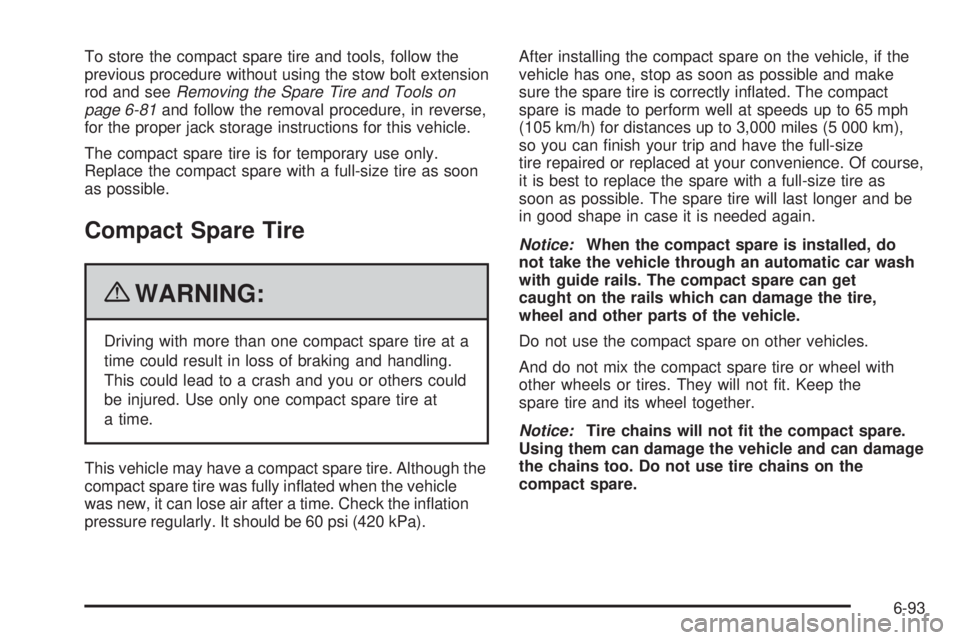
To store the compact spare tire and tools, follow the
previous procedure without using the stow bolt extension
rod and seeRemoving the Spare Tire and Tools on
page 6-81 and follow the removal procedure, in reverse,
for the proper jack storage instructions for this vehicle.
The compact spare tire is for temporary use only.
Replace the compact spare with a full-size tire as soon
as possible.
Compact Spare Tire
{WARNING:
Driving with more than one compact spare tire at a
time could result in loss of braking and handling.
This could lead to a crash and you or others could
be injured. Use only one compact spare tire at
a time.
This vehicle may have a compact spare tire. Although the
compact spare tire was fully inflated when the vehicle
was new, it can lose air after a time. Check the inflation
pressure regularly. It should be 60 psi (420 kPa). After installing the compact spare on the vehicle, if the
vehicle has one, stop as soon as possible and make
sure the spare tire is correctly inflated. The compact
spare is made to perform well at speeds up to 65 mph
(105 km/h) for distances up to 3,000 miles (5 000 km),
so you can finish your trip and have the full-size
tire repaired or replaced at your convenience. Of course,
it is best to replace the spare with a full-size tire as
soon as possible. The spare tire will last longer and be
in good shape in case it is needed again.
Notice:
When the compact spare is installed, do
not take the vehicle through an automatic car wash
with guide rails. The compact spare can get
caught on the rails which can damage the tire,
wheel and other parts of the vehicle.
Do not use the compact spare on other vehicles.
And do not mix the compact spare tire or wheel with
other wheels or tires. They will not fit. Keep the
spare tire and its wheel together.
Notice: Tire chains will not �t the compact spare.
Using them can damage the vehicle and can damage
the chains too. Do not use tire chains on the
compact spare.
6-93
Page 420 of 422

Specifications and Capacities..........................6-109
Speedometer .................................................. 4-21
Split Folding Rear Seat ..................................... 2-9
Start Vehicle, Remote ....................................... 3-6
Starting the Engine ......................................... 3-22
Steering ........................................................ 5-13
Steering Wheel Controls, Audio .........................4-82
Steering Wheel, Tilt Wheel ................................. 4-3
Storage Areas Center Console ........................................... 3-36
Convenience Net ......................................... 3-36
Cupholders ................................................. 3-36
Driver Storage Compartment .........................3-36
Glove Box .................................................. 3-36
Storing the Tire Sealant and Compressor Kit ......6-79
Stuck in Sand, Mud, Ice, or Snow .....................5-23
Sun Visors ..................................................... 3-15
Sunroof ......................................................... 3-37
T
Tachometer.................................................... 4-21
Taillamps Turn Signal Lamps ...................................... 6-44
Turn Signal, Stoplamps and Back-up Lamps ....6-44
Text Telephone (TTY) Users ............................... 8-6
Theft-Deterrent Feature .................................... 4-81Theft-Deterrent Systems
................................... 3-15
Content Theft-Deterrent ................................3-15
PASS-Key
®III+ Electronic Immobilizer ............3-17
PASS-Key®III+ Electronic Immobilizer
Operation ................................................ 3-17
Tilt Wheel ........................................................ 4-3
Time, Setting .................................................. 4-50
Tires ............................................................. 6-48
Aluminum or Chrome-Plated Wheels, Cleaning ................................................. 6-99
Buying New Tires ........................................ 6-64
Chains ....................................................... 6-70
Changing a Flat Tire .................................... 6-80
Cleaning ................................................... 6-100
Compact Spare ........................................... 6-93
Different Size .............................................. 6-66
If a Tire Goes Flat ....................................... 6-70
Inflation - Tire Pressure ................................6-55
Inspection and Rotation ................................6-62
Installing the Spare Tire ................................6-86
Pressure Light ............................................. 4-29
Pressure Monitor Operation ...........................6-58
Pressure Monitor System ..............................6-56
Removing the Flat Tire ................................. 6-86
Removing the Spare Tire and Tools ...............6-81
Sealant and Compressor Kit .................6-72, 6-79
Sidewall Labeling ......................................... 6-49
12
Page 422 of 422
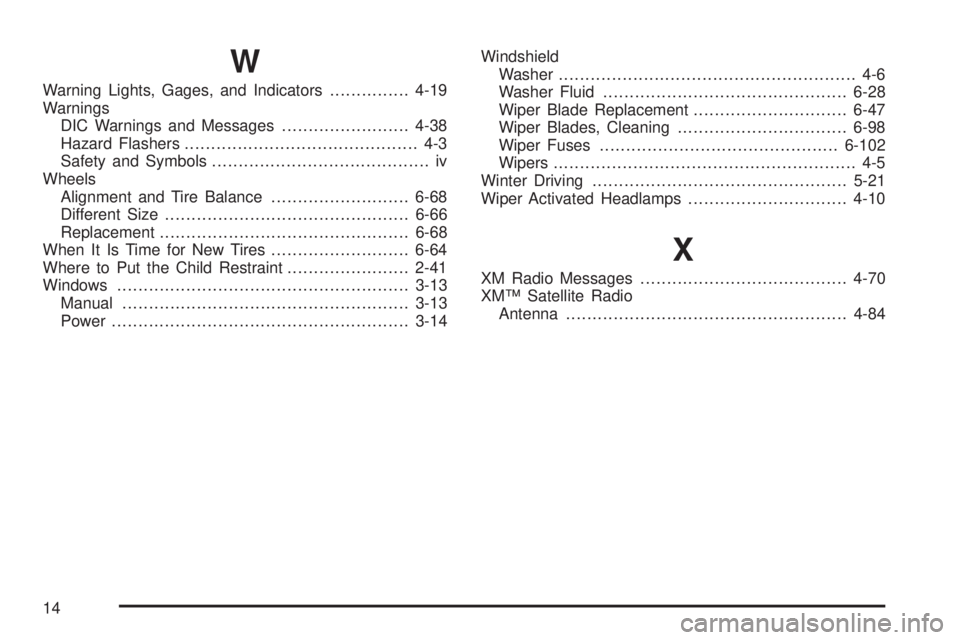
W
Warning Lights, Gages, and Indicators...............4-19
Warnings DIC Warnings and Messages ........................4-38
Hazard Flashers ............................................ 4-3
Safety and Symbols ......................................... iv
Wheels Alignment and Tire Balance ..........................6-68
Different Size .............................................. 6-66
Replacement ............................................... 6-68
When It Is Time for New Tires ..........................6-64
Where to Put the Child Restraint .......................2-41
Windows ....................................................... 3-13
Manual ...................................................... 3-13
Power ........................................................ 3-14Windshield
Washer ........................................................ 4-6
Washer Fluid .............................................. 6-28
Wiper Blade Replacement .............................6-47
Wiper Blades, Cleaning ................................6-98
Wiper Fuses ............................................. 6-102
Wipers ......................................................... 4-5
Winter Driving ................................................ 5-21
Wiper Activated Headlamps ..............................4-10
X
XM Radio Messages....................................... 4-70
XM™ Satellite Radio Antenna ..................................................... 4-84
14